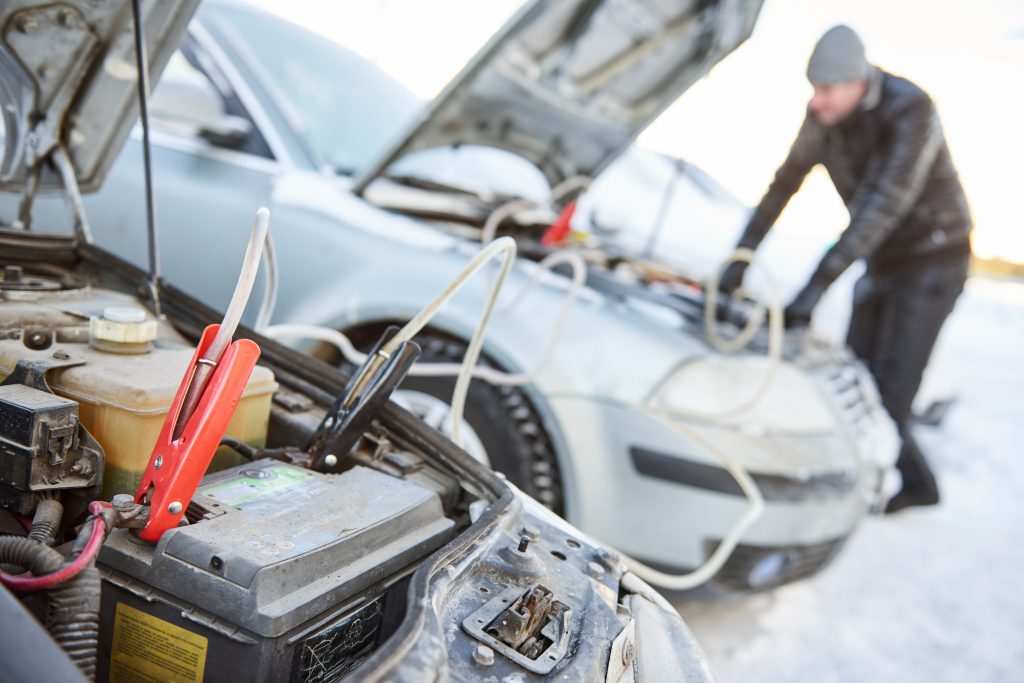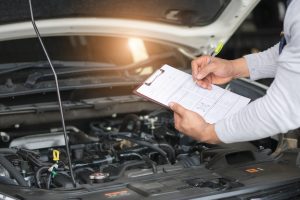Tips & Safe Start Guide

Icy roads, plows shooting up clouds of snow and blinding light bouncing off packed snow cause all sorts of problems for Wisconsin’s drivers, but one of winter’s worst effects come before people even hit the road—winter causes discharged car batteries and vehicle jumpstarting presents a fair share of issues.

Discharged (dead) batteries won’t jumpstart
Car batteries often become discharged in the winter because the cold affects the vehicle in two ways;
- A cold battery has less cranking power than a battery at normal temperature.
- Cold oil is thick oil, and thick oil is harder to turn over in the engine.
While these traits occur independently of each other, they combine and make it harder for vehicles to start, effectively draining a battery down. A discharged battery can oftentimes be recharged and work fine, but immediate action is necessary as a discharged battery could freeze making it unable to be recharged, thus possibly ruining the battery. Charged batteries will not freeze. There are warning signs your battery may be failing.
Traditional Vehicle Batteries vs Hybrid Vehicle Batteries
Discharged batteries can occur in both traditional cars as well as more modern hybrid vehicles. And while many people might know how to jump start a traditional car, the precautions necessary for either jump starting or receiving a jump from a hybrid are slightly different, yet hybrid owners might not even realize this.
“The hybrid is a fundamentally different design and has batteries located in different spots and takes on power differently,” says Smart Motors Master Diagnostic Technician Jason Vasen. “Hybrids with the 12 volt battery inside the passenger compartment like the Prius use an AGM battery which uses absorbed glass mats so there is no “loose” liquid to spray. Some hybrids use conventional 12 volt batteries located outside the passenger compartment which do carry the concern of potential explosion.”

How can one be safe when jump starting a hybrid? Smart Motors’ Jason Vasen put together the following checklists for how to keep vehicles safe and fully powered even through the worst of winter’s fury.
Jumpstarting a hybrid vehicle
- Don’t make a practice of using your hybrid to jump start other vehicles as you could greatly damage the discharged vehicle’s electrical system.
- Apply the parking brake and turn off the headlight switch and interior light.
- Turn off the hybrid system and remove the key if inserted.
- Open the hood; fuse block cover, and exclusive jump starting terminal cover.
- Connect positive clamp (red) jumper cable to the exclusive jump starting terminal.
- Connect the negative clamp (black) to a solid, stationary, unpainted, metallic point of the vehicle with the discharged battery.
- If the booster battery is installed in another vehicle, make sure the vehicles are not touching. Turn off all unnecessary lights and accessories.
- When boosting, use the battery of matching or higher quality. Any other battery may make for a difficult start.
- Allow the discharged battery to rest with the jumper cables connected for approximately 5 minutes. At this time, run the engine in the vehicle with the booster battery at about 2,000 RPM with the accelerator pedal lightly depressed.
- Start the hybrid system. Make sure the “READY” light is on.
- Disconnect the cables in reverse order: the negative cable and then the positive cable.
Jumpstarting a traditional vehicle
- Park the booster vehicle close but not touching the one that needs to be jumped.
- Begin the process by clamping one of the positive jumper cable ends (red) to the positive battery terminal (labeled with a “+” on the battery) of the discharged vehicle.
- Connect the other end of the positive cable (red) to the positive battery terminal on the booster vehicle (again, confirm that a “+” is next to the battery terminal).
- Connect the negative cable end (black) to the negative battery terminal on the booster car (marked with a “-“). Finally, attach the other end of the negative cable to an unpainted metal surface on the engine of the discharged car.
- Start the discharged vehicle and let the two vehicles idle for a few minutes.
- Once the discharged vehicle is started and running smoothly, disconnect the jumper cables in the reverse order that they were connected.
- Drive the revived car to somewhere safe and secure before shutting off the engine.
Smart Motors was founded in 1908 by O.D. Smart and is one of the nation’s oldest automotive dealerships. Smart Motors is the mid-west’s largest hybrid dealer, and is located at 5901 Odana Road, Smart Motors is Wisconsin’s only dealership to have ever earned the coveted President’s Cabinet Award from Toyota Motor Sales. This award is only given to the top 12 dealerships nationwide for superior customer service & sales volume. To learn more about Smart Motors, visit their dealership history page.



